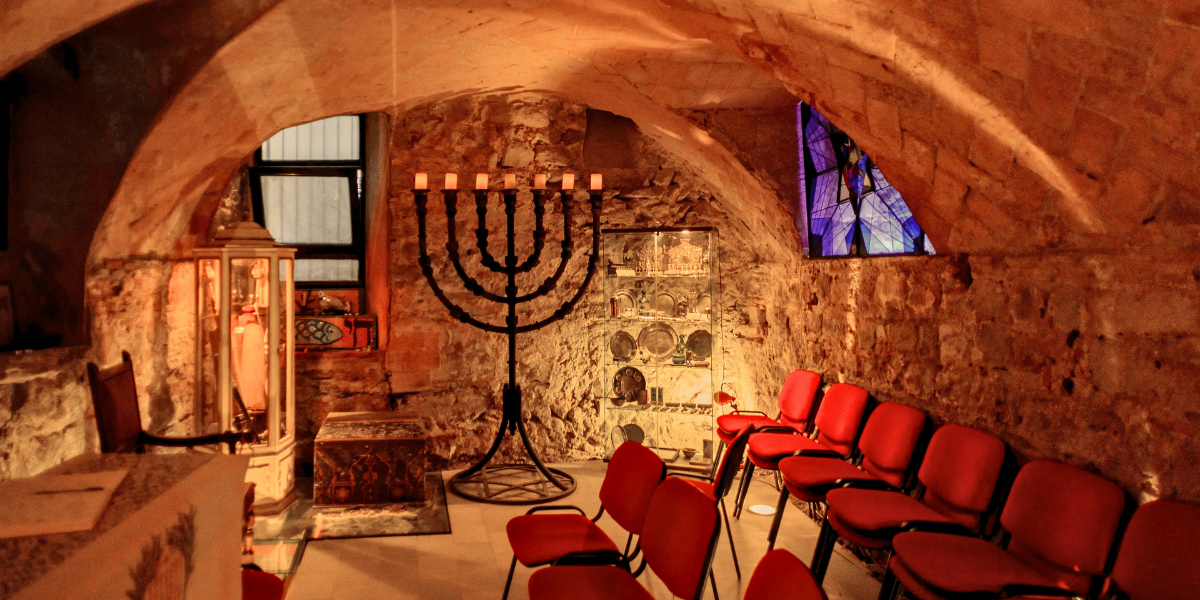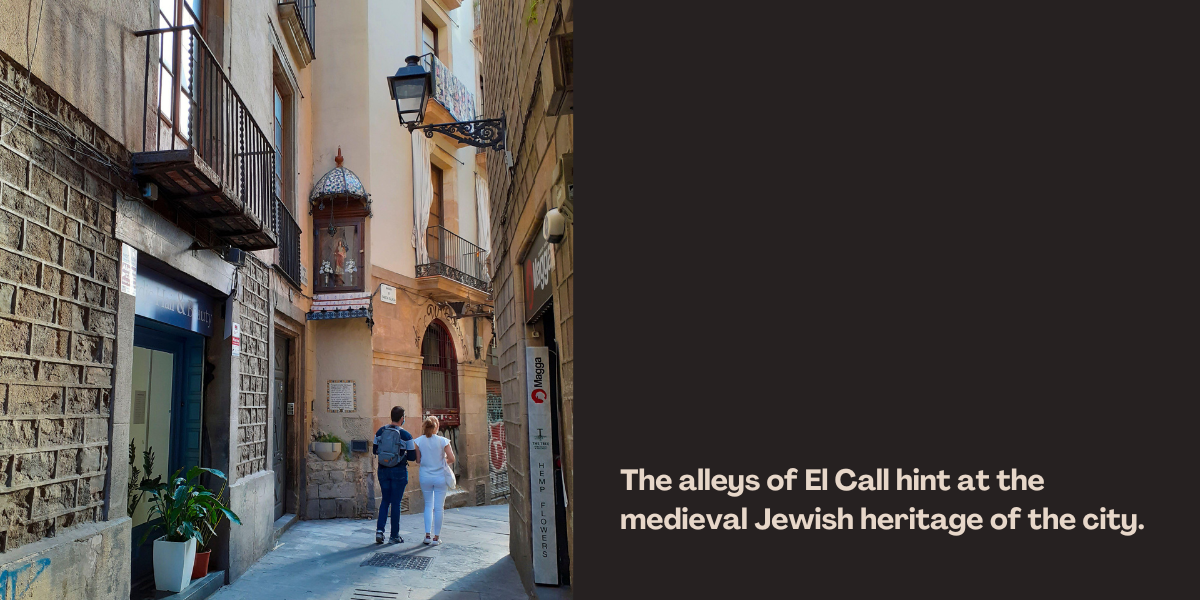The Jewish Traveler
Perennially Popular Barcelona

Deep in the heart of Barcelona’s famous Gothic Quarter is a synagogue out of a Jewish joke: It’s the one nobody attends.
The grandly named Sinagoga Mayor (Great Synagogue) sounds like it ought to be the city’s central temple. Instead, it’s the site of excavated ruins of what some scholars believe is Barcelona’s medieval central synagogue. Spooky and atmospheric, the series of basement rooms have no congregation and host no routine worship. But it is a tourist staple and advertises its availability for foreigners’ bar and bat mitzvahs.
This is the Jewish Barcelona most Jewish tourists see. Americans often visit Europe for history and heritage, and the capital of Spain’s Catalonia region obliges with the remnants of a medieval Jewish district known as El Call (pronounced “al kye”), a center of Sephardi life before the Jews’ expulsion. Here the observant passerby can discern Hebrew letters etched into the alleys’ damp stone walls, though most dwellings were last inhabited by actual Jews long before Columbus sailed.
What sets Barcelona apart from most European cities, from a Jewish perspective, is how distinct its modern Jewish community is from that Sephardi heritage. Today’s Jewish Barcelona, with some 6,000 residents, is served mostly by a handful of synagogues in nondescript uptown buildings far from the tourist scrum. There, amid dental offices and hair salons, the majority of Jewish life takes place. These are congregations that have coalesced within the past century, indeed most in recent decades.
Their constituents are an eclectic group, including Israeli businesspeople, Argentine writers, Venezuelan doctors, British retirees and North African French restaurateurs. They are only the latest to discover Barcelona, which has attracted newcomers since classical times to its port on Spain’s mountainous Northeast coast, about two hours’ drive from the French border. The first Jewish community here dates back 2,000 years to the Roman period; a distinctive Catalan identity predates Barcelona’s incorporation into modern Spain.
As is true for its Jews, Catalonia’s capital city has seen its fortunes wax and wane over the centuries. Along with its northern neighbor, Girona, Barcelona was a center of Jewish merchant and intellectual life during the 12th and 13th centuries. It hosted legendary rabbis like Moses Ben Nachman, a Talmudic sparring partner of Maimonides known as Nahmanides, and Shlomo Ben Adret, for whom a major Gothic Quarter street is named. The latter’s family home has been renovated and opened to the public as Casa Adret, a Jewish cultural center.
The alleys of El Call (right) hint at the medieval Jewish heritage of the city and include the major sight of the Sinagoga Mayor (left). Alamy

During the century preceding the 1492 conquest of all of Spain by Catholic rulers King Ferdinand II and Queen Isabella, however, Catalonia’s approximately 4,000 Jews were subject to a campaign of persecution. While some converted, most fled east to seek refuge in the Ottoman Empire. With its intellectual class decimated by the loss of Jewish and Arab scientists and doctors, Spain went into a long decline. By the early 20th century, Barcelona was a cultural backwater.
The contemporary phenomenon known as Barcelona—the city whose hyper-popularity has made it the nexus of Europe’s contemporary anti-tourism movement that decries the resultant rising housing costs and teeming crowds—was born under the international Olympic spotlight in 1992, when officials debuted a glittering Mediterranean waterfront on the erstwhile site of an industrial port. Alongside a palm-lined promenade, tons of imported sand transformed a workaday fishing town into a global beach destination that now welcomes almost 16 million tourists annually. The resulting attention has also renewed interest in the city’s 19th-century architectural splendors, including Art Nouveau masterpieces and the surreal concoctions of Antoni Gaudí.
Even if you’ve visited before, you may be shocked by just how packed the popular districts are, especially in summer, and how thoroughly foreign speech has saturated even peripheral neighborhoods where Catalan was until recently the lingua franca.
Those looking for the “real” Barcelona should accept that the city has been globalized past the point of return by both tourists and transplants; its authentic self is now multiethnic, multilingual and culturally syncretic.
Amid this renaissance, Barcelona’s largely expat and immigrant Jewish community boasts five synagogues, among them the Orthodox Comunidad Israelita de Barcelona, which became the first modern congregation when it was founded by German Ashkenazim in 1918. More recently, the community has welcomed a lively Chabad center, a Masorti (Conservative and egalitarian) synagogue, a progressive shul and—bringing Jewish life here full circle—a small but growing Orthodox congregation in the Gothic Quarter, reviving ritual life in El Call after more than 600 years.
What to See
Barcelona boasts the world’s only Michelin-starred restaurant to offer a kosher menu. Xerta, upon request and under Chabad supervision, will prepare kosher versions of its lauded coastal-inspired cuisine. Tucked into a hotel in the uptown Eixample district, Xerta lies midway between the Gothic Quarter and the hilly zones that are home to most Jewish institutions (and families).
The Eixample—really a sprawling collection of elegant 19th century neighborhoods—is also home to some of Antonio Gaudí’s best-known masterworks. Here you’ll find two landmark buildings, La Pedrera-Casa Milà and Casa Battlò, on Barcelona’s main shopping boulevard of Passeig de Gràcia, and the Sagrada Família church nearby.

Near the Chabad center in Les Corts, an uptown residential area, is Taím, a kosher cafe beloved by visiting Jews for its takeout meals and Shabbat catering. The city’s oldest modern synagogue, Comunidad Israelita de Barcelona, is nearby, as is the Comunitat Jueva Atid de Catalunya, the Masorti congregation. Both welcome visitors with advance notice.
In the Gothic Quarter, kosher eateries are right on iconic tree-lined Las Ramblas, which slices through the medieval center and links the central Plaza Catalunya with Barcelona’s waterfront. Just steps from the Teatre Liceu, the city’s opera house, Restaurant Maccabi offers an elegant kosher oasis from Spain’s ubiquitous ham-and-shrimp menus, with a selection that includes Spanish specialties like paella (chicken or vegetable) and stuffed eggplant.
Also off Las Ramblas is the popular Boquería, Barcelona’s famous central covered market, where hungry tourists will find popular kosher takeout spot Shani’s Falafel. (This part of Barcelona is also one of Europe’s most infamous pickpocketing hotspots; don’t bring anything extraneous and keep a firm hand on your wallet or purse.)

Nearby, the historic Jewish quarter, El Call, is tucked into the city’s medieval core, roughly bounded by the streets Banys Nous (a Catalan reference to the Jewish ritual baths once located on this street), Sant Sever, Bisbe and the Plaça Sant Jaume. Aside from a few Hebrew inscriptions on the narrow walls of Carrer del Call, the district’s eponymous thoroughfare, and the Sinagoga Mayor—the excavated ruins thought to be the site of the city’s main medieval synagogue—Barcelona’s Sephardi Jewish heritage is most evident in its place names.
While the sights are open by day—including a Chabad-run souvenir shop for kosher wine and books on Honoré Street—the best time to wander the quarter is late at night. After bars have closed and most tourists have left, one can easily imagine medieval Jewish life amid the winding alleys.
El Born, the trendier half of Barcelona’s medieval district, lies across Via Laietana from the Gothic Quarter. It is home to the Picasso Museum, featuring predominantly early works by the young artist testing his technique and experimenting with style.
The best way to experience El Born’s Palau de la Música Catalana, a fabulous Modernist landmark, is to attend a concert in its lavish but intimate theater. Nearby, the Parc de la Ciutadella is a favorite picnic spot; at its southern end is Barcelona’s worthwhile zoo.

Sunny, mild weather makes the city’s waterfront appealing year-round. Starting in Barceloneta, the beachside neighborhood adjacent to El Born, a wide, sandy strip extends north for miles, lined by a promenade dotted with the beach bars known as chiringuitos and thronged by bicyclists and rollerbladers.
To the south, the Gothic Quarter is bounded by a vertiginous green bluff known as Montjuïc—“Mountain of the Jews” in old Catalan, the site of a vanished medieval Jewish cemetery. Today, apart from magnificent views over the city and sea, Montjuïc offers a light-filled museum dedicated to artist and native son Joan Miró, shady botanical gardens and a palace complex that leads to the National Museum of Catalonia.
Hilary Danailova writes about travel, culture, politics and lifestyle for numerous publications.








 Facebook
Facebook Instagram
Instagram Twitter
Twitter
Dominique Tomasov says
“legendary rabbis like Moses Ben Nachman, a Talmudic sparring partner of Maimonides known as Nahmanides”
These two figures lived a century apart, and had totally opposite positions regarding interpretation. In fact, that caused a controversy amongst scholars that was dufficult to settle.
“… Shlomo Ben Adret …family home has been renovated and opened to the public as Casa Adret, a Jewish cultural center.”
The last owner of that house (1391) was an Adret who did not live in Barcelona, and it is unknown if he was related to S. ben Adret (who died in 1310)